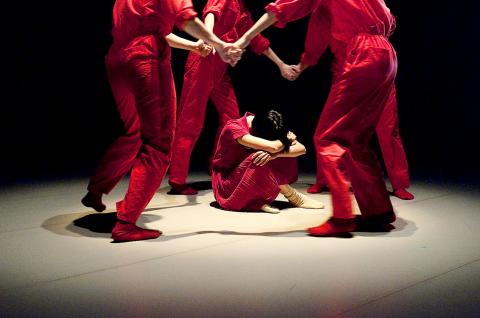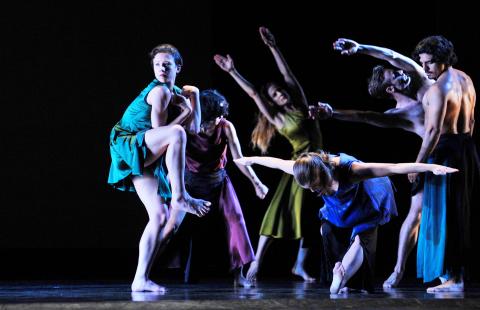Buoyancy and light were the order of the day at the National Theater in Taipei last weekend, while the Experimental Theater was filled with loneliness and despair — and cherry red jumpsuits.
The Mark Morris Dance Group on Saturday night exceeded the high expectations that had heralded its arrival, while Scarecrow Contemporary Dance Company’s (稻草人現代舞蹈團) latest production, Singular (單‧身), upstairs in the Experimental Theater earlier in the day, gave a rather depressing outlook on life.
Morris’ mixed program opened with a recent work, last year’s Crosswalk, set to Carl Maria von Weber’s Grand Duo Concertant, for Clarinet and Piano, which was light and lyrical, though with a hint of underlying darkness. The work exemplifies his musicality and imagination. The dancers — women dressed in tangerine and orange tops and skirts, the men in white T-shirts and dark pants — run, skip and tumble across the stage in bursts of energy. However, in the midst of all this fun, pushing and shoving between two women and one man belie the lightness that surround them.

Credit: Courtesy of Liu Ren-haur / Scarecrow Contemporary Dance Company
All Fours, from 2003, is set to Bela Bartok’s String Quartet No. 4, emitted a much darker mood. The demanding music evokes feelings of uncertainty, which are reflected in the stark, harsh movements of the dancers, who frequently clasp their hands above their heads as if in desperate prayer.
Symmetry is key to Festival Dance which premiered in 2011 and is set to Johann Nepomuk Hummel’s Piano Trio No. 5 in E Major. The piece begins and ends with a couple embracing to the right of the stage. The 12 dancers twirl in pairs or divide in half, joining hands for geometric line dancing. The movements are reminiscent of simpler times, of village fetes and harvest celebrations, and brought to mind Jerome Robbins’ Dances at a Gathering. The piece represents what so many love about Morris’ work — the lush romantic lyricism and grace of classical ballet, but without the tutus, tights and toe shoes.
A key element to all three works on the program was that the dancers were accompanied by the troupe’s seven-man music ensemble, in various formations. The rippling notes of the piano appeared to give added lift to the dancers in Crosswalk and Festival Dance. Dance just seems to breathe to live music and music has always been the key to Morris’ works.

Photo: Mandy Cheng, AFP
The Mark Morris Dance Group will perform at the Tainan Municipal Cultural Center in Greater Tainan tomorrow and Friday. Friday night will be the same program I saw; tomorrow night is Program A, which is composed of two pieces set to Mozart — Eleven, set to Piano Concerto No. 11 in F major, K. 413, and Double, set to Sonata for Two Pianos in D major, K. 448 and Grand Duo, which is set to Lou Harrison’s Grand Duo for Violin and Piano.
Scarecrow artistic director and choreographer Luo Wen-jinn (羅文瑾) cited US author Paul Auster’s The Invention of Solitude as inspiration for Singular, which follows a “Time Wanderer” — whose image was derived from Luo’s father — through different eras and a multitude of meetings, partings, separations and rejections.
A quick look at the names of some of the other characters in the program and it is easy to see there will be no happy endings: Kid Without Love, Lonely Woman, Mother With Hollow Soul and Rejected Girl.
Luo shows that isolation is not just a human concept, with her fighting fish scenes and a flock of panicked birds. The pain comes from the repeated attempts by the rejected to insert themselves into pairings and group activities despite continual rebuffs.
The vast white tiled wall that formed the backdrop to Singular conveyed both an image of modern urban in Taiwan, with its omnipresent tiled apartment buildings, and formed a barrier that kept the characters trapped within their stories.
Despite the painful subject, the choreography and the eight dancers, including Luo herself, were always interesting to watch. Most of the dancers portrayed multiple roles that required repeated quick costume changes, so kudos to their off-stage helpers who made that happen.
With Singular, Scarecrow Contemporary Dance Company continues to demonstrate that a troupe does not have to be based in Taipei to remain topical, edgy or adventurous.
This story has been amended since first published to correct the photo captions.

In the March 9 edition of the Taipei Times a piece by Ninon Godefroy ran with the headine “The quiet, gentle rhythm of Taiwan.” It started with the line “Taiwan is a small, humble place. There is no Eiffel Tower, no pyramids — no singular attraction that draws the world’s attention.” I laughed out loud at that. This was out of no disrespect for the author or the piece, which made some interesting analogies and good points about how both Din Tai Fung’s and Taiwan Semiconductor Manufacturing Co’s (TSMC, 台積電) meticulous attention to detail and quality are not quite up to

April 21 to April 27 Hsieh Er’s (謝娥) political fortunes were rising fast after she got out of jail and joined the Chinese Nationalist Party (KMT) in December 1945. Not only did she hold key positions in various committees, she was elected the only woman on the Taipei City Council and headed to Nanjing in 1946 as the sole Taiwanese female representative to the National Constituent Assembly. With the support of first lady Soong May-ling (宋美齡), she started the Taipei Women’s Association and Taiwan Provincial Women’s Association, where she

Chinese Nationalist Party (KMT) Chairman Eric Chu (朱立倫) hatched a bold plan to charge forward and seize the initiative when he held a protest in front of the Taipei City Prosecutors’ Office. Though risky, because illegal, its success would help tackle at least six problems facing both himself and the KMT. What he did not see coming was Taipei Mayor Chiang Wan-an (將萬安) tripping him up out of the gate. In spite of Chu being the most consequential and successful KMT chairman since the early 2010s — arguably saving the party from financial ruin and restoring its electoral viability —

It is one of the more remarkable facts of Taiwan history that it was never occupied or claimed by any of the numerous kingdoms of southern China — Han or otherwise — that lay just across the water from it. None of their brilliant ministers ever discovered that Taiwan was a “core interest” of the state whose annexation was “inevitable.” As Paul Kua notes in an excellent monograph laying out how the Portuguese gave Taiwan the name “Formosa,” the first Europeans to express an interest in occupying Taiwan were the Spanish. Tonio Andrade in his seminal work, How Taiwan Became Chinese,